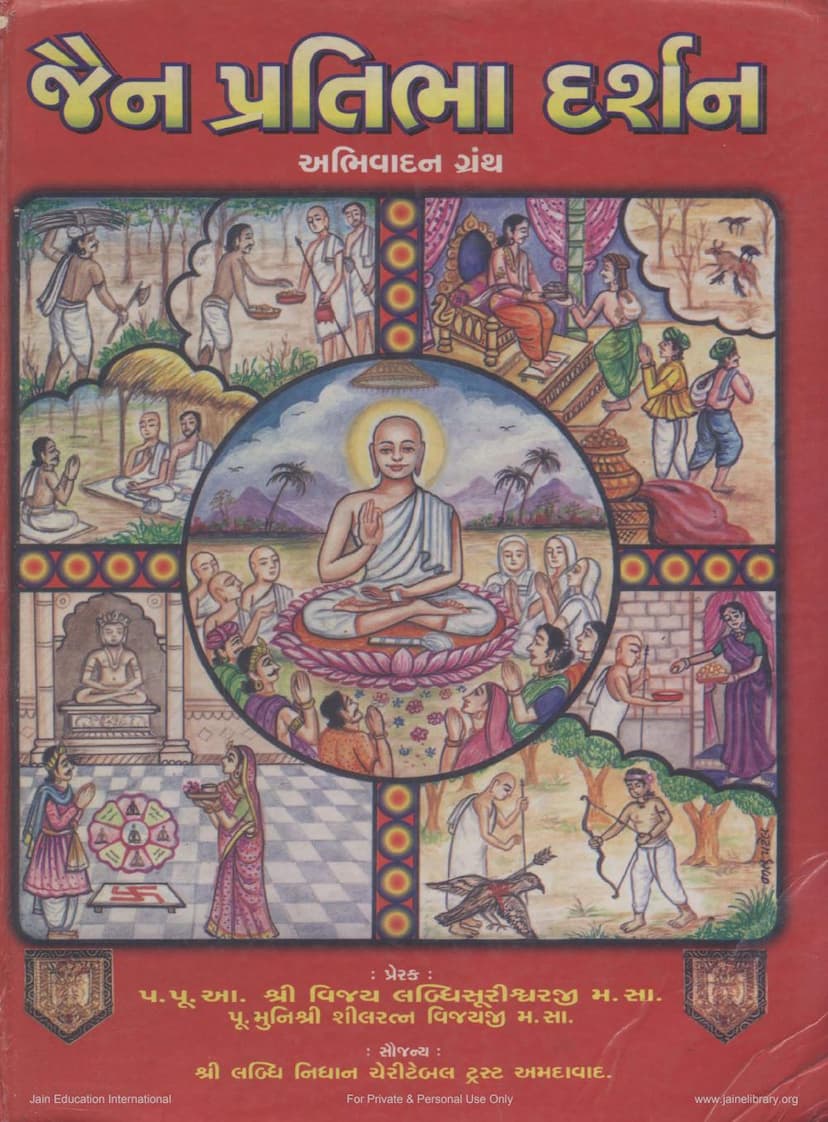Jain Pratibha Darshan
Added to library: September 2, 2025

Summary
Here's a summary of the Jain text "Jain Pratibha Darshan" based on the provided content:
Book Title: Jain Pratib પ્રત્યક્ષો દર્શન (Jain Pratibha Darshan) Author: Nandlal B Devluk Publisher: Arihant Prakashan
This book, "Jain Pratibha Darshan," is an extensive compilation that delves into the lives and contributions of various significant figures within Jainism, focusing on their spiritual achievements, virtuous qualities, and impact on Jainism's propagation. The text is structured to showcase the "pratibha" (splendor, brilliance, genius) of individuals across different spheres of life, highlighting their devotion, renunciation, austerity, knowledge, and service to the faith.
Key Themes and Content:
- Gurutva (The Importance of Gurus): The book heavily emphasizes the profound role of Gurus in the Jain tradition. It quotes scriptures and sayings that highlight the Guru as the source of knowledge, liberation, and spiritual progress, underscoring the necessity of Guru's grace and guidance.
- Praise for Acharyas and Munis: A significant portion of the book is dedicated to venerating numerous Jain Acharyas, Acharya Bhagwants, Munis, and Sadhvis. Their lives are presented as exemplars of spiritual discipline, knowledge, tapas (austerity), and impact on the Jain community and society. The text frequently offers salutations ("Tasmai Shri Gurave Namah") to these revered figures.
- Highlighting Virtuous Qualities (Pratibha): The book systematically explores different facets of spiritual and ethical excellence, such as:
- Dana Dharma (Charity): Numerous examples showcase immense generosity and the selfless use of wealth for the upliftment of the Jain community and the promotion of Dharma.
- Brahmacharya (Celibacy/Chastity): The text emphasizes the power of brahmacharya and provides stories of individuals who adhered to it, leading to profound spiritual progress and even attaining Keval Gyan (omniscience).
- Tapasya (Austerity): The book details the rigorous and inspiring ascetic practices undertaken by many Jain monks and nuns, showcasing their dedication to overcoming karmic impurities.
- Bhav Dharma (Devotion/Inner Spirituality): It highlights the importance of sincere devotion and inner spiritual experience over mere outward rituals.
- Navkar Mantra Sadhana: The profound power and efficacy of reciting the Navkar Mantra are frequently mentioned and illustrated through various anecdotes.
- Matrutva Pratibha (Motherhood's Splendor): The text includes inspiring stories of Jain mothers who played a crucial role in nurturing spiritual values and guiding their children towards Dharma.
- Jain Shasan ki Kirtigatha (Glory of Jainism): The book traces the historical impact of Jainism, from ancient times through various dynasties, rulers, and influential figures who patronized and propagated the faith.
- Historical Narratives and Biographies: The book is rich with biographical sketches and historical anecdotes of prominent Jain individuals. These narratives often focus on:
- Lives of Saints and Ascetics: Stories of Acharyas, Munis, and Sadhvis who dedicated their lives to spiritual pursuit and propagating Jain principles.
- Noble Lay Followers (Shravaks and Shravikas): It extensively features the lives of exemplary lay followers who exemplified Jain ideals in their daily lives, demonstrating the practical application of Dharma in worldly affairs, including their contributions to building temples, supporting the monastic order, and upholding righteousness.
- Royal Patronage: The text includes accounts of kings and queens who were devoted to Jainism, supported the Sangha, and promoted Jain principles in their kingdoms, often highlighting their significant contributions to the construction and preservation of Jain Tirths (sacred sites).
- Miraculous Events and Devotion: Many stories recount instances of divine intervention, the power of devotion, and the impact of virtuous deeds, showcasing the spiritual potency within the Jain tradition.
- The Concept of "Because they were Sadhus": A recurring theme, particularly in the biographical sketches of monks, is the underlying reason for their spiritual prowess and impact: their dedication to the monastic path ("karana ke te sadhu hata"). This phrase suggests that their extraordinary achievements were a direct result of their commitment to the vows, austerities, and spiritual practices of Jain ascetics.
- Compilation of Virtuous Lives: The book serves as a comprehensive "directory" or "encyclopedia" of Jain luminaries. It aims to provide readers with a glimpse into the lives of individuals who embodied Jain virtues and contributed significantly to the faith's enduring legacy.
- Inspiration for Future Generations: The underlying purpose of presenting these diverse "pratibhas" is to inspire readers, particularly the younger generation, to understand and emulate the noble examples of their predecessors, thereby strengthening their connection to Jainism, its culture, and its values.
- The Role of Faith and Devotion: The book repeatedly highlights how unwavering faith, deep devotion, and sincere practice of vows and principles were instrumental in the spiritual journeys and societal contributions of these Jain figures.
Overall:
"Jain Pratibha Darshan" is a monumental work that aims to preserve and propagate the glorious heritage of Jainism by showcasing the exemplary lives of its saints, scholars, and devoted lay followers. It serves as a source of inspiration, knowledge, and spiritual guidance, reinforcing the timeless values and principles of Jain Dharma. The book emphasizes that the brilliance and achievements of these individuals stemmed from their deep commitment to the spiritual path of Jainism, encapsulated by the phrase "because they were Sadhus."